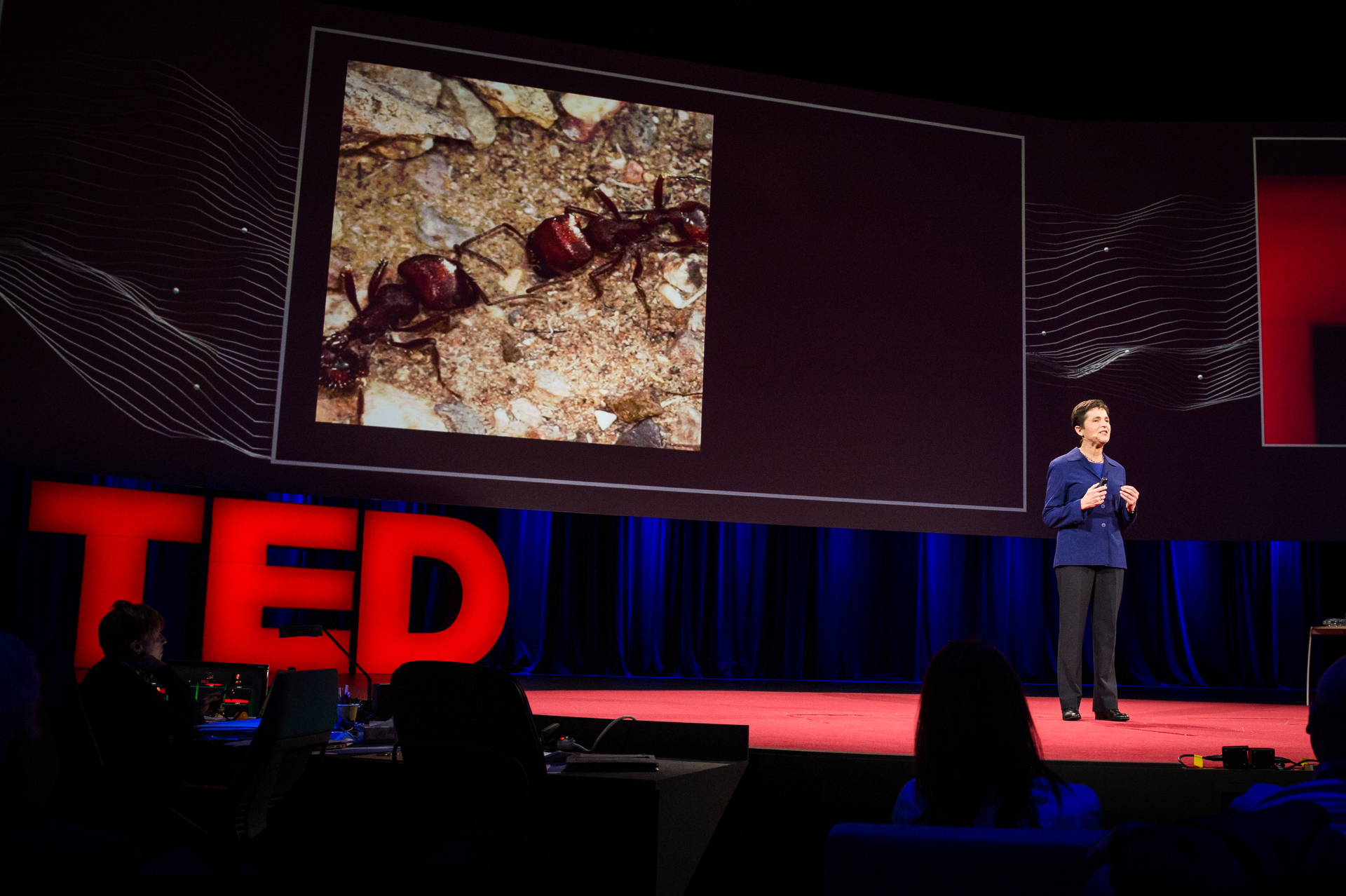“I study ants in the desert, in the tropical forest and in my kitchen,” says Deborah Gordon.
An ecologist, she researches the behavior of ant colonies — which are systems that operate without central control. (While they have a queen, Gordon explains, the queen only lays eggs and doesn’t actually issue orders.) Gordon thinks that, from ants, we can learn a lot about similar systems like the brain, data networks and even the growth of cancer cells.
Ants use their antennae to smell and interact. When they touch antennae with another ant, they receive quite a bit of information—including if an ant is from their colony and what task it’s been doing. “These interactions taken together produce a network,” says Gordon. “It’s this constantly shifting network that shapes the behavior of the colony.”
In other words, ants use interactions differently to meet the challenges of their environments. In the desert, for example, foraging for food—which contains in it water—has a high operating cost. “Ants have to spend water to get water,” says Gordon. In this environment, new foragers don’t go out to hunt for food unless they receive a certain number of positive interactions from foragers returning from the same task. “The system is set to stop unless interactions turn it positive,” says Gordon. It’s the same way the brain works—neurons add up stimulation from other neurons to determine whether to fire.
Different colonies set different thresholds for foraging. On dry days, some colonies conserve much more than others. Gordon was fascinated to find that offspring colonies — colonies founded by daughter queens — resemble their parent colonies in the algorithm they use to control foraging, even though they live far away and couldn’t have learned the behavior. Gordon was also surprised to find that the colonies that conserve are more likely to have offspring colonies. “I thought colony 154 was a loser,” she says, pointing to a colony that turns out to not only have offspring but grandchildren. “But colony 154 was in fact a huge success—a matriarch, one of the rare great-grandmothers. To my knowledge, this is the first time that we’ve been able to track the ongoing evolution of collective behavior.”
Interestingly, the way ants modulate foraging is remarkably similar to the algorithm the internet uses to control the flow of data. “Data doesn’t leave the source computer unless it gets the signal that there’s a place for it,” says Gordon. It was designed this way because, for so long, the cost of operation was high. “Ants are using a similar algorithm to one that we only recently invented,” says Gordon. “Ants have had 130 million years to evolve a lot of good ones. Some of the other 12,000 species have other interesting algorithms for data networks that we haven’t even thought of yet.”
Now, Gordon takes us to the tropics, where ant colonies face a different challenge—while there’s lots of food, there’s also lots of competition for it from other colonies. In these regions, “the system is set to go unless interactions turn it negative,” says Gordon. As ants wander and interact, they are sure to encounter ants from other colonies and, when this happens, the system pulls back. Gordon shows us a photo of an ant using its body to plug the hole to the colony when a threat was detected. “That could be useful for computer security—we could block access temporarily in response to a specific threat and then open it again when the threat’s passed instead of trying to build some kind of firewall.”
Ants also have a lot to teach us about a challenge in robotics—collective search. “Rather than sending a single, expensive robot out to explore another planet or search a burning building, it may be more effective to get a team of cheap robots sharing minimal info,” says Gordon. “That’s the way ants do it.” She explains how ants have mastered the art of expandable search networks. They’ve figured out how to use interactions to expand or contract their loops—when they are crowded and have a lot of interactions, they take tight paths and search them thoroughly. When they are sparse and meet infrequently, they trade off thoroughness to cover more territory. To gather data about how ants behave in crowded spaces, Gordon send a colony up in the International Space Station, where they are forced to cling to the walls, or ceiling, or whatever you call it, and compete for space in new ways. (She’s still analyzing the data that came back.)
So why do ants come marching across your picnic blanket, searching for your strawberries? Ants look for “clustered resources” and so, when an ant wanders upon a feast, it uses interactions to recruit other foragers to see if more is to be had. Hence, ants marching in a line.
Gordon wonders if this information could be helpful in treating cancer. Gordon explains that there are many types of cancer and that they develop in one area and metastasize in another area that has the resources it needs. “If those resources are clustered, they could be using interactions for recruitment,” says Gordon. “If we understood the way cancer cells used recruitment, maybe we could set traps to catch them before they become established.”
This is what we know now. And Gordon wonders what other ant wisdom may come from other colonies. She asks us all to observe and study ants.
“Using only simple interactions, ant colonies have been performing amazing feats for 130 million years,” she says. “We have a lot to learn from them.”

Comments (1)
Pingback: 12 Wonderful Words from TED | Wordnik